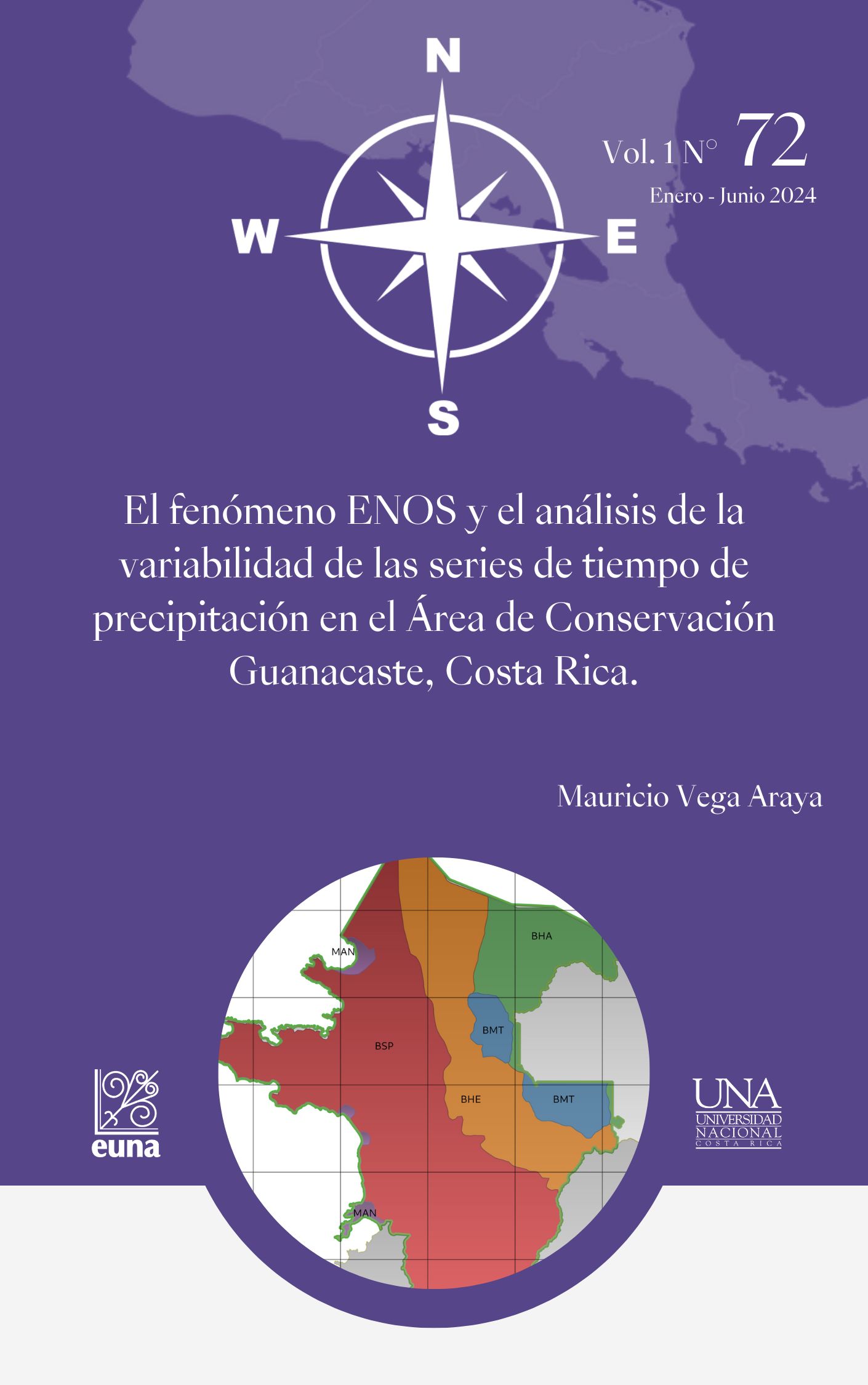El fenómeno ENOS y el análisis de la variabilidad de las series de tiempo de precipitación en el Área de Conservación Guanacaste, Costa Rica.
DOI:
https://doi.org/10.15359/rgac.72-18Palabras clave:
Área de Conservación Guanacaste, precipitación, ecorregiones, ENOSResumen
El pacífico noroeste de Costa Rica es una región con una estacionalidad en el régimen de lluvias muy marcada. Sumado a dicha estacionalidad, esta área de Costa Rica es propensa a fenómenos hidroclimáticos extremos como sequías e inundaciones, por ejemplo. La escasa distribución de pluviómetros o bien, la no disponibilidad de información pertinente, hacen que los datos complementarios obtenidos de satélites y sus respectivas reanálisis, sean fundamentales para disponer de información crucial y así poder fundamentar las acciones de gestión del recurso hídrico y sus repercusiones en los ecosistemas, tanto naturales como productivos. Para analizar los patrones de precipitación, se analizaron las series de tiempo de precipitación del producto CHIRPS para cinco ecorregiones delimitadas en el Área de Conservación Guanacaste, en el Pacífico noroeste de Costa Rica. Estas curvas se correlacionaron con las series de tiempo de las regiones de monitoreo de la temperatura superficial del mar en las regiones Niño 1.2, Niño 3, Niño 3.4 y Niño 4. Todas las ecorregiones analizadas correlacionaron de forma negativa y fuertemente con la región del Niño 1.2, con valores de R entre -0.72 y -0.74. Por otra parte, se detectó un rezago en la curva de Niño 4 de cuatro a cinco meses, con la curva de la región Niño 1.2. El estudio sugiere que la anomalía del Niño 4, con un desfase de aproximadamente 4 a 5 meses, puede ser utilizada como indicador de posibles impactos en los patrones de precipitación en las diferentes ecorregiones estudiadas. Este tiempo es suficiente para planear acciones, sobre todo en el sector agroproductivo. En este trabajo se muestra el potencial de predictibilidad de los efectos del fenómeno ENOS sobre el patrón de la precipitación para áreas extensas y con cierta homogeneidad ecosistémica, como son las ecorregiones en el Área de Conservación Guanacaste.
Referencias
Allen, K; Allen, K., Dupuy, J., Gei, M., Hulshof, C., Medvigy, D., Pizano, C, Salgado, B, et al. (2017). Will Seasonally Dry Tropical Forests Be Sensitive or Resistant to Future Changes in Rainfall Regimes? Environmental Research Letters, 12(2). https://doi.org/10.1088/1748-9326/aa5968.
Awange, J; Hu, K; Khaki, M. (2019). The Newly Merged Satellite Remotely Sensed, Gauge and Reanalysis-Based Multi-Source Weighted-Ensemble Precipitation: Evaluation over Australia and Africa (1981–2016). Science of the Total Environment, 670, 448–65.
Awange, J; Forootan, E. (2016). An Evaluation of High-Resolution Gridded Precipitation Products over Bhutan (1998–2012). International Journal of Climatology, 36(3), 1067–87.
Beck, H, Vergopolan, N; Pan, M; Levizzani, V; Van Dijk, A; Weedon, P; Brocca, P; Pappenberger, F; Huffman, G and Wood, E. (2017). Global-Scale Evaluation of 22 Precipitation Datasets Using Gauge Observations and Hydrological Modeling. Hydrology and Earth System Sciences, 21(12), 6201–17.
Cleveland, R; Cleveland, J; Terpenning, I. (1990). A Seasonal-Trend Decomposition Procedure Based on Loess (with Discussion). Journal of Official Statistics, 6(1).
Comité Regional de Recursos Hidráulicos CRRH y Sistema de la Integración Centroamericana SICA. (2019). El Niño Oscilación Del Sur (Enos). CRRH-SICA https://centroclima.org/wp-content/uploads/2019/02/El_Ni%C3%B1o_febrero_2019.pdf.
Corlett, R. (2016). The Impacts of Droughts in Tropical Forests. Trends in Plant Science, 21(7), 584–93. https://doi.org/https://doi.org/10.1016/j.tplants.2016.02.003.
Dee, P; Uppala, S; Simmons, A; Berrisford, P; Poli, P; Kobayashi, S; Andrae, U; et al. (2011). The Era-Interim Reanalysis: Configuration and Performance of the Data Assimilation System. Quarterly Journal of the Royal Meteorological Society, 137(656), 553–97.
Dinku, T., Funk, C., Peterson, P., Maidment, R., Tadesse, T., Gadain, H., & Ceccato, P2018). Validation of the Chirps Satellite Rainfall Estimates over Eastern Africa. Quarterly Journal of the Royal Meteorological Society, 144, 292–312.
Evans, J. (1996). Straight Forward Statistics for the Behavioral Sciences. Brooks/Cole Pub. Co, Pacific Grove.
Funk, C., Peterson, P; Landsfeld, P; Pedreros, D Verdin, J; Rowland, B; Romero, Husak, G; Michaelsen, J; and Verdin, A (2015). A Quasi-Global Precipitation Time Series for Drought Monitoring: U.S. Geological Survey Data Serie,s 832. https://doi.org/https://doi.org/10.1038/sdata.2015.66.
.Gorelick, N, Hancher, M; Dixon, M; Ilyushchenko, S; Thau, D; and Moore, R (2017). Google Earth Engine: Planetary-scale Geospatial Analysis for Everyone. Remote Sensing of Environment. https://doi.org/https://doi.org/10.1016/j.rse.2017.06.031.
Harris, I., Jones, P. D., Osborn, T., & Lister, D. (2014). Updated High-Resolution Grids of Monthly Climatic Observations–the Cru Ts3. 10 Dataset. International Journal of Climatologyt, 34(3), 623–642.
Hersbach, H., Bell, B., Berrisford, P., Hirahara, S., Horányi, A., Muñoz‐Sabater, Jet al. (2020). The Era5 Global Reanalysis. Quarterly Journal of the Royal Meteorological Society, 146(730), 1999–2049.
Hsu, K; Gao, X; Sorooshian, S, and Gupta, H. (1997). Precipitation Estimation from Remotely Sensed Information Using Artificial Neural Networks. Journal of Applied Meteorology and Climatology, 36(9), 1176–90.
Huffman, G, Bolvin, D., Nelkin, E; Wolff, D., Adler, R., Gu, G., ... Stocker, E. (2007). The TRMM Multisatellite Precipitation Analysis (TMPA): Quasi-global, multiyear, combined-sensor precipitation estimates at fine scales. Journal of Hydrometeorology, 8(1), 38-55.
Kidd, C., Bauer, P., Turk, J., Huffman, G., Joyce, R., Hsu, K., & Braithwaite, D (2012). Intercomparison of High-Resolution Precipitation Products over Northwest Europe. Journal of Hydrometeorology, 13(1), 67–83.
Kummerow, C., Barnes, W., Kozu, T., Shiue, J., & Simpson, J. (1998). The Tropical Rainfall Measuring Mission (TRMM) Sensor Package. Journal of Atmospheric and Oceanic Technology, 15(3), 809–817.
Losada, T., Rodriguez-Fonseca, B., Mohino, E., Bader, J., Janicot, S., & Mechoso, C. R. (2012). Tropical SST and Sahel Rainfall: A Non-Stationary Relationship. Geophysical Research Letters, 39(12).Ministerio de Planificación-Ministerio de Agricultura y Ganadería. (2015). Plan General de la Emergencia por Sequia. Según Decreto Ejecutivo N° 38642-MP-MAG, publicado en La Gaceta N°195, del viernes 10 de octubre del 2014. San José, Costa Rica. CNE. MP-MAG. https://www.pgrweb.go.cr/scij/Busqueda/Normativa/Normas/nrm_texto_completo.aspx?param1=NRTC&nValor1=1&nValor2=78091&nValor3=98281&strTipM=TC#ddown.
NASA. (2000). Digital Elevation Model - SRTM 1 Arc-Second 30m. NASA, NGA. http://lpdaac.usgs.gov
National Centers for Environmental Information. (s.f). Equatorial Pacific Sea Surface Temperatures. https://www.ncei.noaa.gov/access/monitoring/enso/sst.
National Weather Service, Climate Prediction Center (sf). Monthly Atmospheric & SST Indices. http://www.cpc.ncep.noaa.gov/data/indices/sstoi.indices.
Olson, D; Dinerstein, E. (2002). The Global 200: Priority Ecoregions for Global Conservation. http://maps.tnc.org/gis_data.html.
Personal del Área de Conservación Guanacaste. (2022). Sitio Web Del área de Conservación Guanacaste.
Pfeifer, M., Gonsamo, A., Woodgate, W., Cayuela, L., Marshall, A. R., Ledo, A.,,Paine, P; Marchant, P; et al. (2018). Tropical Forest Canopies and Their Relationships with Climate and Disturbance: Results from a Global Dataset of Consistent Field-Based Measurements. Forest Ecosystems, 5. https://doi.org/10.1186/s40663-017-0118-7.
Powers, J. S., Vargas G, G., Brodribb, T. J., Schwartz, N. B., Pérez‐Aviles, D., Smith‐Martin, C. M., ... & Medvigy, D. (2020). A Catastrophic Tropical Drought Kills Hydraulically Vulnerable Tree Species. Global Change Biology, 26(5), 3122-3133. https://doi.org/10.1111/gcb.15037
Qin, Y., Chen, Z., Shen, Y., Zhang, S., & Shi, R. (2014). Evaluation of Satellite Rainfall Estimates over the Chinese Mainland. Remote Sensing, 6(11), 11649–72.R Core Team. (2021). R: A Language and Environment for Statistical Computing. Vienna, Austria: R Foundation for Statistical Computing. https://www.R-project.org/.
Schneider, U., Becker, A., Finger, P., Meyer-Christoffer, A., Ziese, M., & Rudolf, B. (2014). GPCC’s New Land Surface Precipitation Climatology Based on Quality-Controlled in Situ Data and Its Role in Quantifying the Global Water Cycle. Theoretical and Applied Climatology, 115(1), 15–40.
Serrat, A; Valdes, J; Stakhiv, E. (2014). Water Management Applications for Satellite Precipitation Products: Synthesis and Recommendations. JAWRA Journal of the American Water Resources Association, 50(2), 509–25.
Sorooshian, S., Hsu, K;., Gao, X., Gupta, H., Imam, B., & Braithwaite, D. (2000). Evaluation of Persiann System Satellite-Based Estimates of Tropical Rainfall. Bulletin of the American Meteorological Society, 81(9), 2035–46.Tang,
L., Tian, Y., Yan, F., & Habib, E (2015). An Improved Procedure for the Validation of Satellite-Based Precipitation Estimates. Atmospheric Research, 163, 61–73.
Trenberth, K. (1997). The Definition of El Niño. Bulletin of the American Meteorological Society, 78(12), 2771–7. http://www.cgd.ucar.edu/staff/trenbert/trenberth.papers/defnBAMS.pdf.
Wang, B., Liu, J., Kim, H. J., Webster, P. J., Yim, S. Y., & Xiang, B (2013). Northern Hemisphere Summer Monsoon Intensified by Mega-El Nino/Southern Oscillation and Atlantic Multidecadal Oscillation. Proceedings of the National Academy of Sciences of the United States of America, 110(14), 5347–5352. https://doi.org/10.1073/pnas.1219405110Wilks, D. (2011). Statistical Methods in the Atmospheric Sciences. Academic press.
Wu, W., Li, Y., Luo, X., Zhang, Y., Ji, X., & Li, X (2019). Performance Evaluation of the Chirps Precipitation Dataset and Its Utility in Drought Monitoring over Yunnan Province, China. Geomatics, Natural Hazards and Risk, 10(1), 2145–62.
Yan, G; Yi, L; Xi, C. (2018). Evaluating Satellite-Based Precipitation Products in Monitoring Drought Events in Southwest China. International Journal of Remote Sensing, 39(10), 3186–3214.
Yun, K; Lee, J. Timmermann, A; and et al. (2021). Increasing Enso–Rainfall Variability Due to Changes in Future Tropical Temperature–Rainfall Relationship. Communications Earth & Environment. https://doi.org/10.1038/s43247-021-00108-8.
Zambrano, M. (2020). HydroTSM: Time Series Management, Analysis and Interpolation for Hydrological Modelling. https://github.com/hzambran/hydroTSM.

Descargas
Publicado
Cómo citar
Número
Sección
Licencia
Derechos de autor 2024 Mauricio Vega-Araya

Esta obra está bajo una licencia internacional Creative Commons Atribución-NoComercial-CompartirIgual 4.0.
Política propuesta para Revistas que ofrecen Acceso Abierto
Los autores que publican en esta revista están de acuerdo con los siguientes términos:
a. Los autores conservan los derechos de autor y garantizan a la revista el derecho de ser la primera publicación del trabajo, bajo la Licencia https://creativecommons.org/licenses/by-nc-sa/4.0/deed.es, que permite a otros compartir con un reconocimiento de la autoría del trabajo y la publicación inicial en esta revista.
b. Los autores pueden establecer por separado acuerdos adicionales para la distribución no exclusiva de la versión de la obra publicada en la revista (por ejemplo, situarlo en un repositorio institucional o publicarlo en un libro), con un reconocimiento de su publicación inicial en esta revista. Esos acuerdos adicionales deben respetar los términos de la licencia: es decir: no involucrar fines de lucro y compartir con la misma licencia.
c. Se anima a los autores a archivar el post-print o versión de editor/PDF en repositorios de acceso abierto.






 REVGEO se encuentra bajo la licencia https://creativecommons.org/licenses/by-nc-sa/4.0/deed.es
REVGEO se encuentra bajo la licencia https://creativecommons.org/licenses/by-nc-sa/4.0/deed.es
.svg_4.png)

_(1).png)
_(1)_(1)_(1)_1.png)
(2)(1)(1)(1).png)
